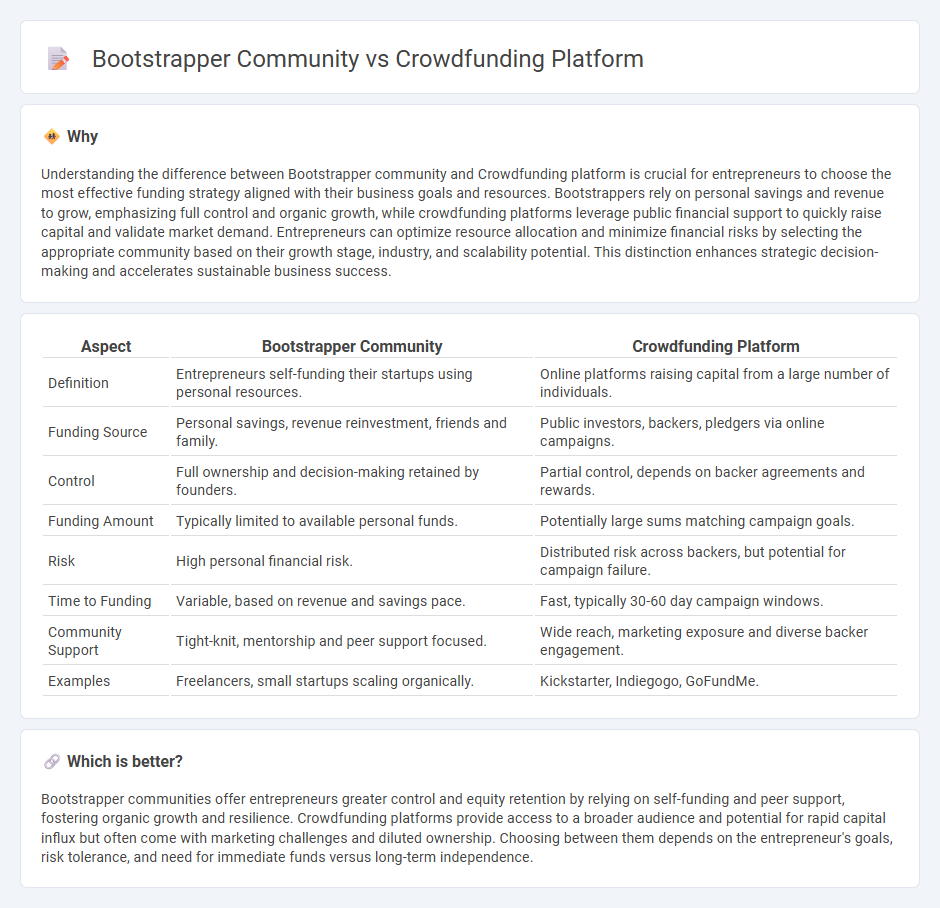
Bootstrapper communities empower entrepreneurs to build ventures using personal savings and internal resources, fostering independence and control over business decisions. Crowdfunding platforms connect startups with a wide audience of potential investors, facilitating capital raising through collective financial support while often providing marketing exposure. Explore how each funding approach shapes entrepreneurial success and find the best fit for your venture.
Why it is important
Understanding the difference between Bootstrapper community and Crowdfunding platform is crucial for entrepreneurs to choose the most effective funding strategy aligned with their business goals and resources. Bootstrappers rely on personal savings and revenue to grow, emphasizing full control and organic growth, while crowdfunding platforms leverage public financial support to quickly raise capital and validate market demand. Entrepreneurs can optimize resource allocation and minimize financial risks by selecting the appropriate community based on their growth stage, industry, and scalability potential. This distinction enhances strategic decision-making and accelerates sustainable business success.
Comparison Table
| Aspect | Bootstrapper Community | Crowdfunding Platform |
|---|---|---|
| Definition | Entrepreneurs self-funding their startups using personal resources. | Online platforms raising capital from a large number of individuals. |
| Funding Source | Personal savings, revenue reinvestment, friends and family. | Public investors, backers, pledgers via online campaigns. |
| Control | Full ownership and decision-making retained by founders. | Partial control, depends on backer agreements and rewards. |
| Funding Amount | Typically limited to available personal funds. | Potentially large sums matching campaign goals. |
| Risk | High personal financial risk. | Distributed risk across backers, but potential for campaign failure. |
| Time to Funding | Variable, based on revenue and savings pace. | Fast, typically 30-60 day campaign windows. |
| Community Support | Tight-knit, mentorship and peer support focused. | Wide reach, marketing exposure and diverse backer engagement. |
| Examples | Freelancers, small startups scaling organically. | Kickstarter, Indiegogo, GoFundMe. |
Which is better?
Bootstrapper communities offer entrepreneurs greater control and equity retention by relying on self-funding and peer support, fostering organic growth and resilience. Crowdfunding platforms provide access to a broader audience and potential for rapid capital influx but often come with marketing challenges and diluted ownership. Choosing between them depends on the entrepreneur's goals, risk tolerance, and need for immediate funds versus long-term independence.
Connection
Bootstrapper communities thrive on resourcefulness and self-funding, creating a robust network of entrepreneurs who prioritize lean startups. Crowdfunding platforms connect these entrepreneurs with a broader audience, providing critical capital and validating business ideas through public support. Together, they empower startups by combining grassroots innovation with accessible funding, accelerating early-stage growth and market entry.
Key Terms
Funding source
Crowdfunding platforms aggregate funds from a large number of individual backers, often via online campaigns, providing startups and projects with immediate access to capital through small contributions. Bootstrapper communities rely primarily on founders' personal savings, reinvested earnings, and resourcefulness, fostering sustainable growth without external debt or equity dilution. Explore the detailed advantages of each funding source to determine the best strategy for your business goals.
Community support
Crowdfunding platforms harness the power of large-scale online communities to financially back projects, offering creators widespread visibility and access to diverse funding sources. Bootstrapper communities emphasize peer-to-peer support, sharing resources and expertise among entrepreneurs to build sustainable ventures with minimal external funding. Explore how each approach cultivates unique community dynamics and support mechanisms to empower startups.
Ownership control
Crowdfunding platforms allow entrepreneurs to raise capital from a broad audience but often require sharing equity, leading to diluted ownership control. Bootstrapper communities emphasize self-funding and operational independence, enabling founders to maintain full ownership and decision-making authority. Explore deeper contrasts between these funding approaches to determine which best aligns with your ownership goals.
Source and External Links
GoFundMe | The #1 Crowdfunding and Fundraising Platform - GoFundMe is the leading global crowdfunding platform with no fees to start fundraising, trusted by over 100 million people, and raises over $50 million weekly for causes like medical emergencies, charities, and personal fundraisers.
Crowdfunder USA | Fundraising Platform for Americans - Crowdfunder USA offers a 100% fee-free platform for individuals and communities to raise money, ensuring every cent raised goes directly to the cause with no platform or transaction fees, emphasizing community-driven fundraising.
10 Best Crowdfunding Sites and Platforms in 2025 - Shopify - Indiegogo and Kickstarter are notable platforms for businesses and creative projects with flexible funding options, while Indiegogo charges a 5% fee plus transactions fees and offers ongoing fundraising features to support multi-stage projects.
 dowidth.com
dowidth.com